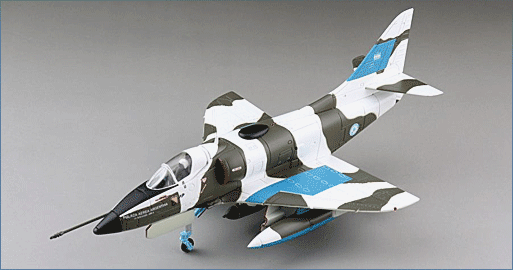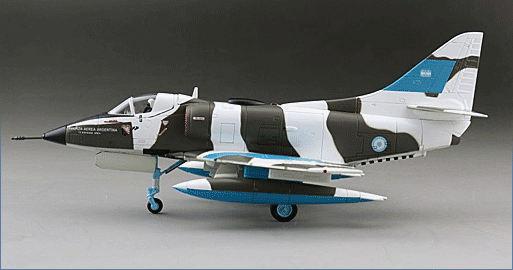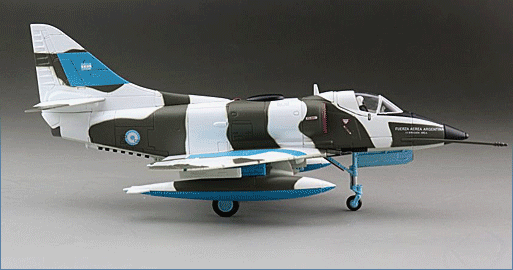Air Power Series>1:72 die-cast display model>A-4>HA1434
A-4C Skyhawk C-321 of IV Grupo de Casa, IV Brigada Aerea,
Fuerza Aerea Argentina, San Julian, 1982




General Background
The A-4 Skyhawk is one of the most successful attack aircrafts ever built. This smallest jet aircraft ever deployed on a carrier was the product of Douglas's Chief Engineer Ed Heinnemann in the 1952. This was the time when a more lightweight aircraft was in demand to fit into those post-war vintage carriers.
The Skyhawk was extensively used during the Cold War period and the Vietnam War by the Navy and the Marines. Because of its small size and powerful performance, the A-4 was also known as the “Heinnemann's Hot Rod”. A total of 2, 960 of Skyhawk were built and many of them were exported to other countries.
The Skyhawk was extensively used during the Cold War period and the Vietnam War by the Navy and the Marines. Because of its small size and powerful performance, the A-4 was also known as the “Heinnemann's Hot Rod”. A total of 2, 960 of Skyhawk were built and many of them were exported to other countries.
The Aircraft
On April 2, 1982 Argentina invaded the Falkland Islands, on April 5th Britain sent a flotilla to engage the Argentine Navy and Air Force and make an amphibious assault on the island. After 74 days Argentina surrendered on June 14 but not before 649 Argentine personnel losing their lives along with 255 British losses and 3 Falkland islanders. Numerous ships and aircraft from both sides were lost. A-4C Skyhawk C-321 of the Grupo de Casa, IV Brigada Aerea, Fuerza Aerea Argentina, San Julian was delivered on March 29, 1978 and took part in the conflict.
Specifications :
| Performance | |
| Engine: | 1 x Pratt & Whitney J52-P-6A turbojet, 8500 lb. of thrust |
| Max speed 673 mph at sea level with a clean aircraft: | 636 mph at sea level with a Mk. 28 |
| Cruising speed: | 498 mph |
| Stall speed: | 139 mph |
| Combat ceiling (clean aircraft): | 40,500 feet |
| Runway to 20,000 ft: | 4 minutes |
| Flight distances: | 230 miles with a Mk. 28 weapon |
| 680 miles with 2 X 300-gallon drop tanks | |
| Ferry range: | 2130 miles |
| Dimensions: | |
| Wingspan: | 27 ft 6 in |
| Length: | 41ft 4 in |
| Height: | 15 ft |
| Wing area: | 260 sq ft |
| Weights | |
| Empty: | 9,624 lb. |
| Gross: | 18,300 lbs. |
| Maximum: | 22,950 lbs |
| Armament: | 2 x 20 mm cannon with 200 rounds/gun |
| Maximum weapons load: | 8,200 lbs. carried on 5 pylons - 2 pylons under each wing and 1 |
| center-line pylon |

